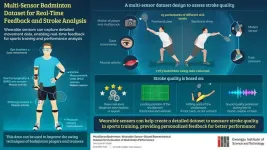(Press-News.org)
In sports training, practice is the key, but being able to emulate the techniques of professional athletes can take a player’s performance to the next level. AI-based personalized sports coaching assistants can make this a reality by utilizing published datasets. With cameras and sensors strategically placed on the athlete's body, these systems can track everything, including joint movement patterns, muscle activation levels, and gaze movements.
Using this data, personalized feedback is provided on player technique, along with improvement recommendations. Athletes can access this feedback anytime, and anywhere, making these systems versatile for athletes at all levels.
Now, in a study published in the journal Scientific Data on April 5, 2024, researchers led by Associate Professor SeungJun Kim from the Gwangju Institute of Science and Technology (GIST), South Korea, in collaboration with researchers from Massachusetts Institute of Technology (MIT), CSAIL, USA, have developed a MultiSenseBadminton dataset for AI-driven badminton training.
“Badminton could benefit from these various sensors, but there is a scarcity of comprehensive badminton action datasets for analysis and training feedback,” says Ph.D. candidate Minwoo Seong, the first author of the study.
Supported by the 2024 GIST-MIT project, this study took inspiration from MIT's ActionSense project, which used wearable sensors to track everyday kitchen tasks such as peeling, slicing vegetables, and opening jars. Seong collaborated with MIT’s team, including MIT CSAIL postdoc researcher Joseph DelPreto and MIT CSAIL Director and MIT EECS Professor Daniela Rus and Wojciech Matusik. Together, they developed the MultiSenseBadminton dataset, capturing movements and physiological responses of badminton players. This dataset, shaped with insights from professional badminton coaches, aims to enhance the quality of forehand clear and backhand drive strokes. For this, the researchers collected 23 hours of swing motion data from 25 players with varying levels of training experience.
During the study, players were tasked with repeatedly executing forehand clear and backhand drive shots while sensors recorded their movements and responses. These included inertial measurement units (IMU) sensors to track joint movements, electromyography (EMG) sensors to monitor muscle signals, insole sensors for foot pressure, and a camera to record both body movements and shuttlecock positions. With a total of 7,763 data points collected, each swing was meticulously labeled based on stroke type, player’s skill level, shuttlecock landing position, impact location relative to the player, and sound upon impact. The dataset was then validated using a machine learning model, ensuring its suitability for training AI models to evaluate stroke quality and offer feedback.
“The MultiSenseBadminton dataset can be used to build AI-based education and training systems for racket sports players. By analyzing the disparities in motion and sensor data among different levels of players and creating AI-generated action trajectories, the dataset can be applied to personalized motion guides for each level of players,” says Seong.
The gathered data can enhance training through haptic vibration or electrical muscle stimulation, promoting better motion and refining swing techniques. Additionally, player tracking data, like that in the MultiSenseBadminton dataset, could fuel virtual reality games or training simulations, making sports training more accessible and affordable, potentially transforming how people exercise.
In the long run, the researchers speculate that this dataset could make sports training more accessible and affordable for a broader audience, promote overall well-being, and foster a healthier population.
***
Reference
DOI: https://doi.org/10.1038/s41597-024-03144-z
About Gwangju Institute of Science and Technology (GIST)
The Gwangju Institute of Science and Technology (GIST) was founded in 1993 by the Korean government as a research-oriented graduate school to help ensure Korea's continued economic growth and prosperity by developing advanced science and technology with an emphasis on collaboration with the international community. Since that time, GIST has pioneered a highly regarded undergraduate science curriculum in 2010 that has become a model for other science universities in Korea. To learn more about GIST and its exciting opportunities for researchers and students alike, please visit: http://www.gist.ac.kr/.
About the authors
SeungJun Kim is an Associate Professor at the Gwangju Institute of Science and Technology (GIST), overseeing the human-centered intelligent systems laboratory. Previously, he served as a special faculty at the Human-Computer Interaction Institute, Carnegie Mellon University, leading research in XR, robotics, and human-AI interaction. Dr. Kim holds a B.S. in Electrical Engineering from KAIST and an M.S. and Ph.D. in Mechatronics from GIST. His research focuses on sensory intelligence and augmentation through multimodal XR in ubiquitous computing environments, recognized with paper awards from UbiComp, IEEE ISMAR, and ACM AutoUI.
Minwoo Seong is an applied AI researcher and specializes in sensory reconstruction of human motions in real and virtual worlds. Seong holds a B.S. in Mechanical Engineering and an M.S. in Robotics from Gwangju Institute of Science and Technology (GIST), from where he is currently pursuing his Ph.D. Seong’s work has earned recognition, including the Best Paper Award from KCC and a runner-up award at the IJCAI 2023.
END
Scientists from the University of Sharjah and the Warburg Institute are poring over the writings of an 11th century Arab-Muslim polymath to demonstrate their impact on the development of optical sciences and how they have fundamentally transformed the history of physics from the Middle Ages up to modern times in Europe.
Their research focuses on the legacy of al-Ḥasan Ibn al-Haytham known in Latin as “Alhazen” and particularly his most influential work titled Book of Optics, reputed in Arabic as Kitab al-Manazir and first circulated in Europe via its Latin translation dubbed ‘Perspectiva’. Ibn ...
Labelling vulnerable patients in hospital as “socially admitted” may prevent treatment of medical issues, according to new research in CMAJ (Canadian Medical Association Journal) https://www.cmaj.ca/lookup/doi/10.1503/cmaj.231430.
Emergency departments are the last resort for some socially vulnerable people who may not have an acute or new medical issue. They may be seeking care because of a breakdown of supports or the inability of the patient, or their family, to cope with living at home. These people are known colloquially as “social admissions,” and other labels such as “orphan patient,” “failure ...
Motorcycles are designed to accommodate the average-sized rider, leaving taller and shorter riders vulnerable to discomfort.
A new study from the University of Waterloo used software that predicted realistic motorcycle riding behaviours, considering human factors and ergonomic trade-offs. It found that shorter and taller statures require joint adjustments to achieve their preferred riding posture.
Taller riders are required to flex their ankles, knees, hips and elbows more to interact with the motorcycle properly, ...
A national survey led by Ann & Robert H. Lurie Children’s Hospital of Chicago found that parents have insufficient knowledge of newborn screening in general and of cystic fibrosis (CF) in particular. Researchers asked specific questions about CF based on studies showing that initial CF follow-up visits after a positive newborn screening often occur after 4 weeks of age, which is later than the recommended timeframe for best outcomes. Later follow-up is associated with worse nutrition in childhood, a predictor of long-term health in CF. Parents ...
About The Study: The findings of this study show a significantly lower pediatric emergency department length of stay and inpatient psychiatric admission rate following pediatric observation unit care and potential savings in inpatient psychiatric resources without contributing to 30-day readmission rates.
Authors: Rachel G. Kasdin, M.S., of the Icahn School of Medicine at Mount Sinai in New York, is the corresponding author.
To access the embargoed study: Visit our For The Media website at this link https://media.jamanetwork.com/
(doi:10.1001/jamapediatrics.2024.1123)
Editor’s Note: Please see the article for additional information, including other authors, ...
LONG BEACH (May 4, 2024) Mariem A. Sawan, MBBS, chief interventional cardiology fellow at Emory University, has been selected as the recipient of the SCAI-Women in Innovations (SCAI-WIN) CHIP Fellowship, the Society for Cardiovascular Angiography and Interventions announced today.
The $115,000 fellowship opportunity was made possible by support from Abiomed (founding supporter), Boston Scientific, Medtronic, and Shockwave Medical, Inc., and is offered to interventional cardiology (IC) fellows or practicing interventional cardiologists ...
LONG BEACH (May 4, 2024) During SCAI 2024 Scientific Sessions, the Society for Cardiovascular Angiography & Interventions (SCAI) presented its "30 in Their 30’s" award to thirty early-career interventional cardiologists.
This award program recognizes the excellence of these members for their outstanding leadership and demonstration of SCAI's core values and is designed to encourage and support young interventional cardiologists who have already made a significant impact in the field.
Recipients include:
Aakash Garg, MD, FSCAI
Adnan Khalif, MD, FSCAI
Alejandro ...
LONG BEACH (May 4, 2024) The Society for Cardiovascular Angiography & Interventions (SCAI) is pleased to announce the selection of 12 new early-career interventional cardiologists to participate in the 2024-2026 Emerging Leader Mentorship (ELM) Program.
The ELM Fellows program is a two-year training and mentorship program designed to help participants enhance their skills and prepare for leadership positions in medicine. The program is offered in collaboration with the American College of Cardiology and the Cardiovascular Research Foundation.
The ELM Selection Committee chose 12 individuals based on their leadership ...
LONG BEACH (May 4, 2024) Today, the Society for Cardiovascular Angiography & Interventions (SCAI) announced its 2025 Master Interventionalists of SCAI (MSCAI) designation recipients during the SCAI 2025 Scientific Sessions in Long Beach.
The MSCAI designation is awarded to individuals who have demonstrated excellence in invasive/interventional cardiology over the course of their career and for their commitment to the highest levels of clinical care, innovation, publication, and teaching.
This year’s MSCAI ...
LONG BEACH (May 4, 2024) James B. Hermiller, MD, MSCAI, director of the Interventional Cardiology Fellowship and the Structural Heart Program at St. Vincent Ascension Heart Center in Indianapolis, IN, assumed the office of president of the Society for Cardiovascular Angiography & Interventions (SCAI) today during the closing ceremonies at the SCAI 2024 Scientific Sessions in Long Beach, CA.
An interventional cardiologist, researcher, and teacher, Hermiller has been an author, leading enroller, primary investigator, and steering committee member in many transcatheter therapy studies, including multiple pivotal trials of structural heart disease. ...









